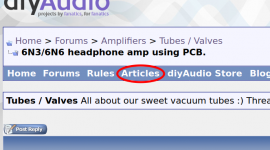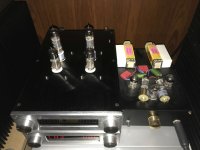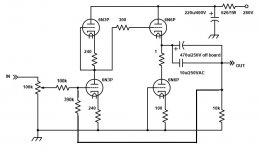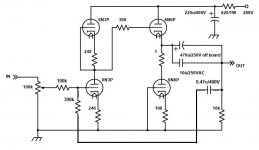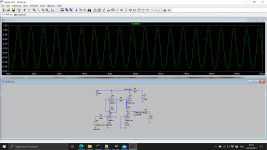Is it the one in Articles, April 2010?There is a good paper on this on eliminating hum loops but I can never find it
Attachments
Would love to hear your subjective impressions as a linestage preamp. What is the over gain?
I dunno how I missed this...
It's transparent, and Last I checked, with 6N3 you have 1Vin=11Vout
Hi kodabmx,
thanks for pointing me over to this thread. Your amp looks very nice and quite interesting.🙂
I have a few dozen of 6N6P, and have to dig for a some 6N3Ps ... and yes, it reminds me of my Aikido 😀
From my experience with 6N6P in headphone amps or as driver tubes, or the second stage in my Aikido, interesting alternatives to try (though not all with the same pin-out) are E182CC, 6N30P, 5687, 12BH7. I work a lot with tube socket adapters ...
Also, I second to try a 6N1P in place of the 6N3P - I am extremely pleased with the 6N1P I am using in my EL84 PP amp that is also based on a John Broskie design ...
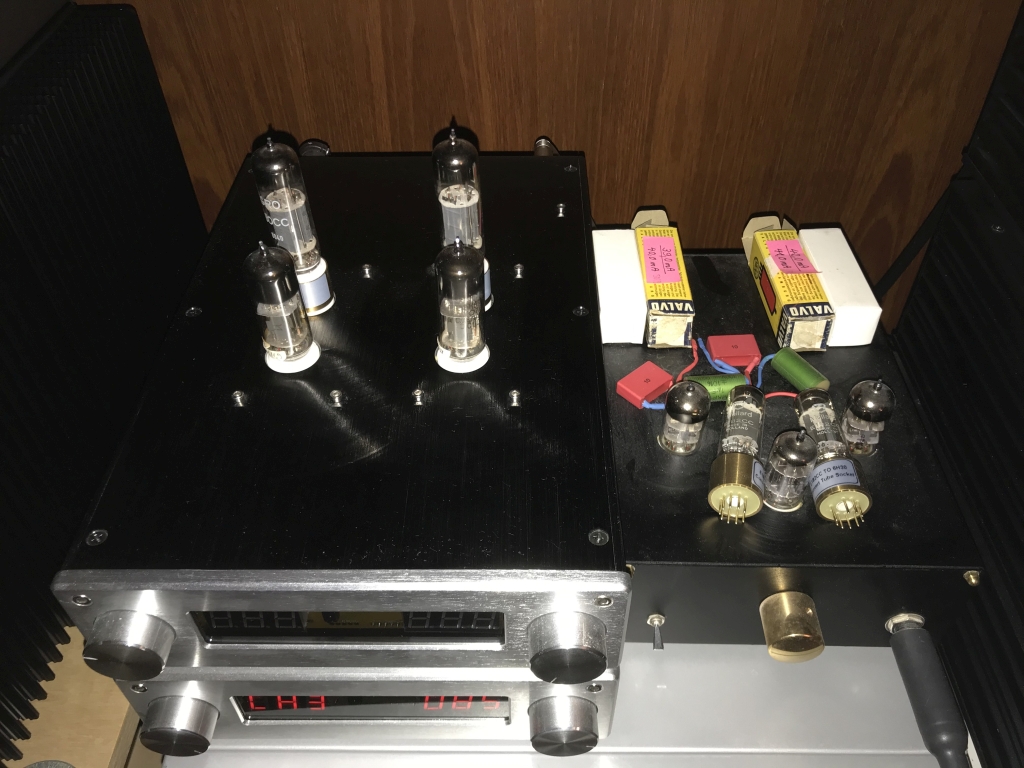
Regards, Claas
thanks for pointing me over to this thread. Your amp looks very nice and quite interesting.🙂
I have a few dozen of 6N6P, and have to dig for a some 6N3Ps ... and yes, it reminds me of my Aikido 😀
From my experience with 6N6P in headphone amps or as driver tubes, or the second stage in my Aikido, interesting alternatives to try (though not all with the same pin-out) are E182CC, 6N30P, 5687, 12BH7. I work a lot with tube socket adapters ...
Also, I second to try a 6N1P in place of the 6N3P - I am extremely pleased with the 6N1P I am using in my EL84 PP amp that is also based on a John Broskie design ...
Regards, Claas
Attachments
Nice looking build, chede!
I also made 2 other versions - one that uses 12AU7 or another 9A pinout tube + 6N6P, and a version with 6N1P/6DJ8 or any other 9AJ pinout tube + 6N6P. $10 for a blank, $50 for a kit, 70$ assembled + shipping and tubes if needed, if anyone still wants to build one 🙂
I also made 2 other versions - one that uses 12AU7 or another 9A pinout tube + 6N6P, and a version with 6N1P/6DJ8 or any other 9AJ pinout tube + 6N6P. $10 for a blank, $50 for a kit, 70$ assembled + shipping and tubes if needed, if anyone still wants to build one 🙂
The size of that trafo!!! People will ask where the OPTs and speaker connectors are!
Well done dude!
Well done dude!
Been listening for a while with my Philips 32 ohms headphones.And at loud volumes it distorts but thats at realy loud levels.
I use 68k as katod resistors.
I use 68k as katod resistors.
You could go lower if the plate dissipation/power supply would allow. I could not find a circuit its probably on post #X
You are at 2.6W in the output stage on both 6N6 so there's little you can do to get more output other than a transformer.
Ok,I canged from 6N6P tp ECC99,and I got a more tranparaent wider sound stage a little less bass.
Has anyone tried wrapping a little NFB around this? Maybe 10dB? (Reduce gain by about 3X.)
If the gain is 11X and the NFB reduces that to about 3X, I figure that's still enough gain for a headphone amp -- especially for the lower impedance ones. Could also be useful as a line stage.
If the gain is 11X and the NFB reduces that to about 3X, I figure that's still enough gain for a headphone amp -- especially for the lower impedance ones. Could also be useful as a line stage.
Attachments
Last edited:
For my 470R cans, there's barely enough volume with a 12AT7 in the front end on some of my tunes even at full blast... If someone were to wrap a loop around it, I'd suggest using 6N2P for the first tube unless they have sensitive phones.
Mine are only 99db.
Also, it's totally also a line stage. Change 6N6P to 6N5P/6N1P/6DJ8 and use 240R for both cathode resistors instead of 1R (or short) and 100R (or 68R) and that's where this gNFB scheme might be handy to reduce the gain - have it switchable.
OTOH, I'd just use a 2:1 attenuator on the input instead. Also as it's drawn, I think the input tube would do strange things as those giant caps charge up and make the grid several volts positive...
Or leave the tubes alone, and use it for both like I do. It drives the inputs of 6 amplifiers and/or my headphones. I use a 10uF cap for the line part because it would be insane to couple line gear with 470uF lol
Koda
Mine are only 99db.
Also, it's totally also a line stage. Change 6N6P to 6N5P/6N1P/6DJ8 and use 240R for both cathode resistors instead of 1R (or short) and 100R (or 68R) and that's where this gNFB scheme might be handy to reduce the gain - have it switchable.
OTOH, I'd just use a 2:1 attenuator on the input instead. Also as it's drawn, I think the input tube would do strange things as those giant caps charge up and make the grid several volts positive...
Or leave the tubes alone, and use it for both like I do. It drives the inputs of 6 amplifiers and/or my headphones. I use a 10uF cap for the line part because it would be insane to couple line gear with 470uF lol
Koda
Last edited:
Agreed, for line use you'd definitely want to change the output cap to something like 4.7uF or 10uF.
You could also put a pair of 15V zeners in opposite polarity across the output to inhibit large voltage spikes being sent out the output cathode.
I'm finding that with most 32 or 50 ohm headphones, I prefer a low output impedance to get the bass to sound good and the mids/highs to sound relaxed. However, if you have 250 ohm, 300 ohm or 600 ohm headphones then never mind -- you may want to leave it open loop for the extra gain.
I have a headphone amp I put together out of two 6DJ8s per channel. One triode is the voltage amp DC coupled to the remaining three triodes wired in parallel as a giant cathode follower. (The output cap is a 100uF 400V electrolytic, with opposite-polarity 15V zeners across the output to clamp voltage spikes.) The Ip of the cathode followers is 11mA each, so that's 33mA of current sourced, and about 30mA/V of gm, for an open loop output impedance of roughly 33 ohms. The open loop gain was about 12X. Left that way the amp choked pretty bad on 32 ohm headphones, but it sounded nice driving 300 ohm Sennheisers.
I added 13dB of NFB and got the output impedance down to 8 ohms. The gain is only about 3X now, but it sounds really fine into the 300 ohm Sennheisers, and still good into a pair of Audio Technica ATH-30X (70 ohms DCR). It sounds a little weak into a pair of Fostex T50RP, but those are a bear to drive (low sensitivity and 60 ohms impedance). I get no scratchy noises when adjusting the volume control pot, even immediately after power on. I should measure the input tube for grid current at power on, though.
I figure the amp's max output power is load/33mA (0.707V rms) or about 21mW into a 33 ohm load. If 1mW gets you 92dB SPL then that's 104dB for 16mW. Isn't that enough?
At any rate, the 13dB of NFB really improved this particular cathode follower/OTL headphone amp, so I figured I'd throw the idea out there.
You could also put a pair of 15V zeners in opposite polarity across the output to inhibit large voltage spikes being sent out the output cathode.
I'm finding that with most 32 or 50 ohm headphones, I prefer a low output impedance to get the bass to sound good and the mids/highs to sound relaxed. However, if you have 250 ohm, 300 ohm or 600 ohm headphones then never mind -- you may want to leave it open loop for the extra gain.
I have a headphone amp I put together out of two 6DJ8s per channel. One triode is the voltage amp DC coupled to the remaining three triodes wired in parallel as a giant cathode follower. (The output cap is a 100uF 400V electrolytic, with opposite-polarity 15V zeners across the output to clamp voltage spikes.) The Ip of the cathode followers is 11mA each, so that's 33mA of current sourced, and about 30mA/V of gm, for an open loop output impedance of roughly 33 ohms. The open loop gain was about 12X. Left that way the amp choked pretty bad on 32 ohm headphones, but it sounded nice driving 300 ohm Sennheisers.
I added 13dB of NFB and got the output impedance down to 8 ohms. The gain is only about 3X now, but it sounds really fine into the 300 ohm Sennheisers, and still good into a pair of Audio Technica ATH-30X (70 ohms DCR). It sounds a little weak into a pair of Fostex T50RP, but those are a bear to drive (low sensitivity and 60 ohms impedance). I get no scratchy noises when adjusting the volume control pot, even immediately after power on. I should measure the input tube for grid current at power on, though.
I figure the amp's max output power is load/33mA (0.707V rms) or about 21mW into a 33 ohm load. If 1mW gets you 92dB SPL then that's 104dB for 16mW. Isn't that enough?
At any rate, the 13dB of NFB really improved this particular cathode follower/OTL headphone amp, so I figured I'd throw the idea out there.
Last edited:
as it's drawn, I think the input tube would do strange things as those giant caps charge up and make the grid several volts positive...
I forgot there's an easy fix for that. Since the feedback resistor is 390k ohms (pretty large) you don't need a huge capacitance to pass all audio frequencies of interest from the output to the input tube's grid, while blocking DC. I think 0.47uF will do, but 1uF might be better if you're worried. A 1uF 400V film cap isn't too big of an ask.
Attachments
You could also put a pair of 15V zeners in opposite polarity across the output to inhibit large voltage spikes being sent out the output cathode.
Agreed, but I'd use a bidirectional TVS because one less part.
For the record, I have ATH-R70x cans and that's what I primarily use.
- Home
- Amplifiers
- Tubes / Valves
- 6N3/6N6 headphone amp using PCB.
